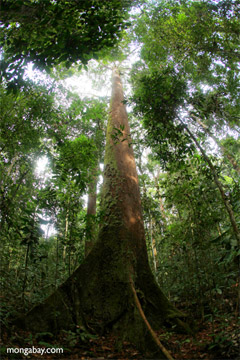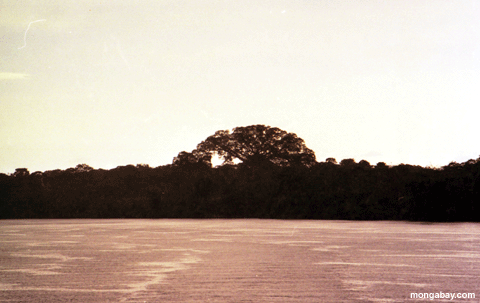mongabay.com. January 26, 2012
Already on the decline, demise of giant trees may be hastened by global warming.

"To persist, big trees need a safe place to live and long periods of stability," he told mongabay.com via email. "But time and stability are becoming very rare commodities in our modern world."
Giant trees offer critical habitat and forage for wildlife, while transpiring massive amounts of water through their leaves, contributing to local rainfall. Old trees also lock up massive amounts of carbon — in some forests they can account for up to a quarter of living biomass.
 Dipterocarps are commonly targeted by loggers in Southeast Asia. This Dipterocarp was photographed in Borneo by Rhett A. Butler. |
Big trees are also sensitive to fragmentation, which exposes them to stronger winds and drier conditions. Laurance's own work in the Amazon has shown substantial die-off of canopy giants in small forest fragments. Their susceptibility seems counter-intuitive given big trees' life histories, which invariably include periods of drought and other stress.
"All around the tropics, big canopy and emergent trees are succumbing to strong droughts," Laurance said. "That's been a surprise to me and many other ecologists, because big, ancient trees would have had to survive many droughts in the past."
Forest giants may suffer disproportionately from climate change, writes Laurance inNew Scientist, highlighting research in La Selva, Costa Rica by David and Deborah Clark.
- "Trees are probably getting a double-whammy when the thermometer rises,' says David Clark. “During the day, their photosynthesis shuts down when it gets too warm, and at night they consume more energy because their metabolic rate increases, much as a reptile’s would do when it gets warmer.” With less energy being produced in warmer years and more being consumed just to survive, there is less energy available for growth.The Clarks’ hypothesis, if correct, means tropical forests could shrink over time. The largest, oldest trees would progressively die off and tend not to be replaced. Alarmingly, this might trigger a positive feedback that could destabilize the climate: as older trees die, forests would release some of their stored carbon into the atmosphere, prompting a vicious circle of further warming, forest shrinkage and carbon emissions.
 Giant Kapok tree in the Brazilian Amazon. Photo by Rhett A. Butler. Giant Kapok tree in the Brazilian Amazon. Photo by Rhett A. Butler. |
No comments:
Post a Comment